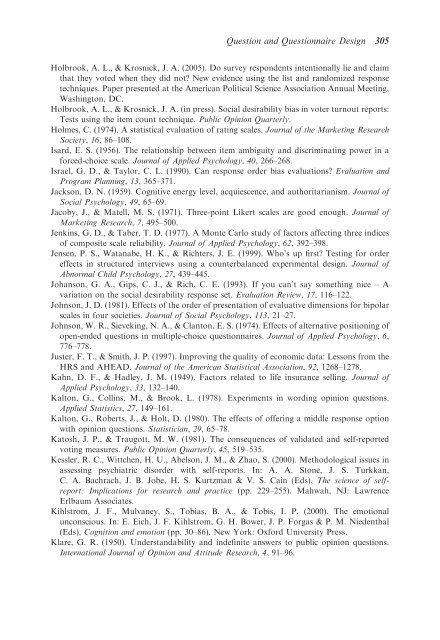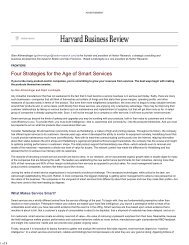Question and Questionnaire Design - Stanford University
Question and Questionnaire Design - Stanford University
Question and Questionnaire Design - Stanford University
You also want an ePaper? Increase the reach of your titles
YUMPU automatically turns print PDFs into web optimized ePapers that Google loves.
<strong>Question</strong> <strong>and</strong> <strong>Question</strong>naire <strong>Design</strong> 305Holbrook, A. L., & Krosnick, J. A. (2005). Do survey respondents intentionally lie <strong>and</strong> claimthat they voted when they did not? New evidence using the list <strong>and</strong> r<strong>and</strong>omized responsetechniques. Paper presented at the American Political Science Association Annual Meeting,Washington, DC.Holbrook, A. L., & Krosnick, J. A. (in press). Social desirability bias in voter turnout reports:Tests using the item count technique. Public Opinion Quarterly.Holmes, C. (1974). A statistical evaluation of rating scales. Journal of the Marketing ResearchSociety, 16, 86–108.Isard, E. S. (1956). The relationship between item ambiguity <strong>and</strong> discriminating power in aforced-choice scale. Journal of Applied Psychology, 40, 266–268.Israel, G. D., & Taylor, C. L. (1990). Can response order bias evaluations? Evaluation <strong>and</strong>Program Planning, 13, 365–371.Jackson, D. N. (1959). Cognitive energy level, acquiescence, <strong>and</strong> authoritarianism. Journal ofSocial Psychology, 49, 65–69.Jacoby, J., & Matell, M. S. (1971). Three-point Likert scales are good enough. Journal ofMarketing Research, 7, 495–500.Jenkins, G. D., & Taber, T. D. (1977). A Monte Carlo study of factors affecting three indicesof composite scale reliability. Journal of Applied Psychology, 62, 392–398.Jensen, P. S., Watanabe, H. K., & Richters, J. E. (1999). Who’s up first? Testing for ordereffects in structured interviews using a counterbalanced experimental design. Journal ofAbnormal Child Psychology, 27, 439–445.Johanson, G. A., Gips, C. J., & Rich, C. E. (1993). If you can’t say something nice – Avariation on the social desirability response set. Evaluation Review, 17, 116–122.Johnson, J. D. (1981). Effects of the order of presentation of evaluative dimensions for bipolarscales in four societies. Journal of Social Psychology, 113, 21–27.Johnson, W. R., Sieveking, N. A., & Clanton, E. S. (1974). Effects of alternative positioning ofopen-ended questions in multiple-choice questionnaires. Journal of Applied Psychology, 6,776–778.Juster, F. T., & Smith, J. P. (1997). Improving the quality of economic data: Lessons from theHRS <strong>and</strong> AHEAD. Journal of the American Statistical Association, 92, 1268–1278.Kahn, D. F., & Hadley, J. M. (1949). Factors related to life insurance selling. Journal ofApplied Psychology, 33, 132–140.Kalton, G., Collins, M., & Brook, L. (1978). Experiments in wording opinion questions.Applied Statistics, 27, 149–161.Kalton, G., Roberts, J., & Holt, D. (1980). The effects of offering a middle response optionwith opinion questions. Statistician, 29, 65–78.Katosh, J. P., & Traugott, M. W. (1981). The consequences of validated <strong>and</strong> self-reportedvoting measures. Public Opinion Quarterly, 45, 519–535.Kessler, R. C., Wittchen, H. U., Abelson, J. M., & Zhao, S. (2000). Methodological issues inassessing psychiatric disorder with self-reports. In: A. A. Stone, J. S. Turkkan,C. A. Bachrach, J. B. Jobe, H. S. Kurtzman & V. S. Cain (Eds), The science of selfreport:Implications for research <strong>and</strong> practice (pp. 229–255). Mahwah, NJ: LawrenceErlbaum Associates.Kihlstrom, J. F., Mulvaney, S., Tobias, B. A., & Tobis, I. P. (2000). The emotionalunconscious. In: E. Eich, J. F. Kihlstrom, G. H. Bower, J. P. Forgas & P. M. Niedenthal(Eds), Cognition <strong>and</strong> emotion (pp. 30–86). New York: Oxford <strong>University</strong> Press.Klare, G. R. (1950). Underst<strong>and</strong>ability <strong>and</strong> indefinite answers to public opinion questions.International Journal of Opinion <strong>and</strong> Attitude Research, 4, 91–96.
















